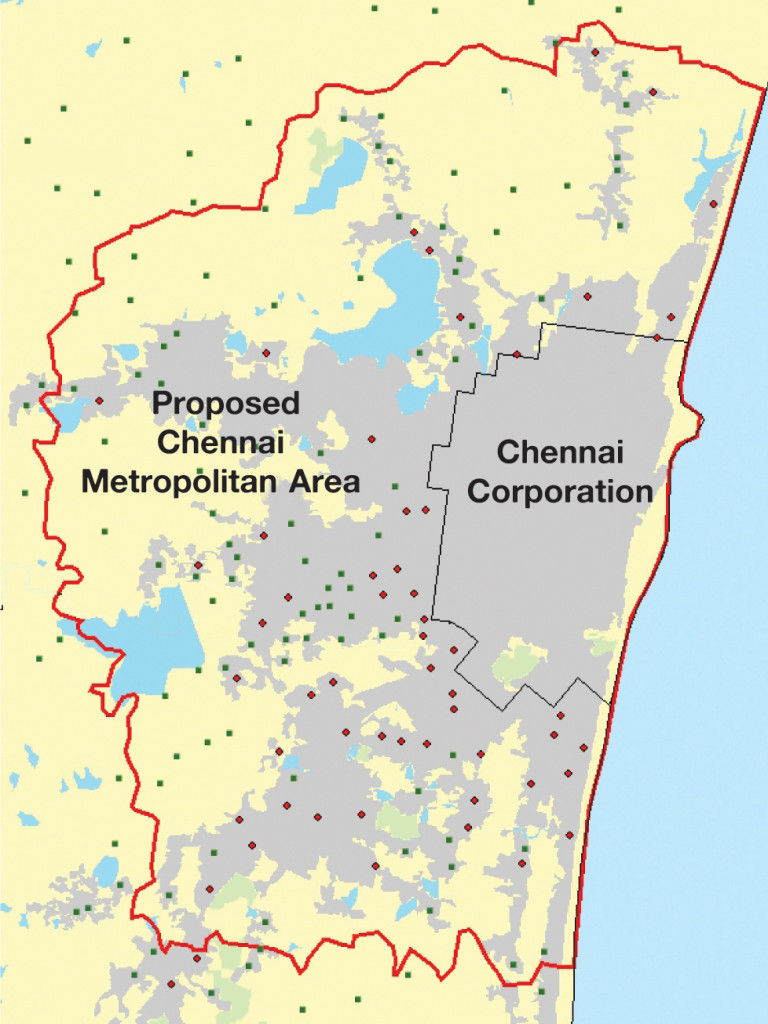Registered with the Registrar of Newspapers for India under R.N.I 53640/91
Vol. XXVIII No. 3, May 16-31, 2018
7-fold expansion not an option
By A Special Correspondent

At present, the Chennai Metropolitan Area is 1,189 sq.km after its notification in 1975. CMDA intends to expand it to 8,878 sq.km engulfing Tiruvallur and Kancheepuram Districts and Arakkonam and Nemili Taluks in Vellore District, Chengalpattu becoming part of the region. The objective is to anticipate the needs of the population by 2026.
Enlargement of the City region, and that too, by over seven times seems highly complex and over ambitious. Reservations on some issues cannot be helped. Have similar objectives, as were spelt out, been achieved for the first expansion to 1189 sq.km? If the answer is in the negative, how is an enlarged area a substitute for sound conception and implementation? If the answer is in the affirmative, would it not be realistic to break the proposed massive expansion into manageable modules, of the same size as for the first expansion, without weakening their organic inter-relationships? Has an expert study been done to assess what needs to be done to result in a positive impact on decongestion, reduced pollution and improved quality of life?
When the area was expanded to 1,189 sq.km, Government reasoned that a large area was needed to find the best possible location for employment, affordable housing and relocation of slums and developing connectivity. This was primarily to be achieved by creating satellite towns and peripheral ring roads.
Of five proposed towns, only two – Manali and Maraimalai Nagar – were accomplished. This has not been adequate to arrest the rising overcrowding in Chennai city. The object of making housing in suburbs an attractive option has not been realised. Reports from residents in outlying areas indicate that local roads have not been put in place nor has the supply of serviced land for middle and lowincome housing been augmented. In the last expansion, some development of the outlying areas took place and private apartments mushroomed, but the expansion was not integrated with mass mobility and public service access plans.
There are reports that even after twenty years the promised supply of piped water is unavailable in the added areas. Projects are claimed to have been completed in 12 out 42 added areas, but residents say that even in the 12 areas water supply is only on paper.
In the City core area also, there is still much scope to reduce congestion and pollution at a cost much lower than going for expansion of area. Speedy completion of all the phases of the Metro, pricing it such that the trains are filled and high priority for replacement of existing heavy-smoking buses by modern non-polluting buses – 4,000 of them have been provided for in the latest Tamil Nadu Budget -would substantially reduce pollution and congestion. Both the Metro and the bus replacement plans are near at hand, but it is a matter of effective governance to transform them speedily into reality. High-rise apartment complexes are becoming the new living option; they accommodate more people per unit of land area, offer the same advantage as lateral extension of area. Verticality or horizontality, both need support utility, public services and infrastructure.
If outcomes are any indication, promises of the first expansion remain unrealised. And the potential to decongest and reduce pollution in the city remain unfulfilled. This may be partly due to incompleteness and partly due to unsuitable solutions “well” completed. This suggests that a serious review is needed to formulate a rescue plan to realise the full potential of the original expansion of 1975.
The net result is what Dr. A. Srivathsan of CEPT University Ahmedabad, which focuses on habitat planning and design, has pointed out. Suburbs are sparsely occupied with 7,448 persons per sq.km while the city is cramped with 26,903 persons per sq.km – and perhaps still growing. These figures, he thinks, show that the existing area of 1,189 sq. km can accommodate even a two-fold future increase in population.
In exploiting the full potential of the existing area, it is necessary to provide the outlying areas a liveable environment with access not only to job opportunities and locations but also to utilities, services, facilities, and amenities so that living in the City is not missed. Mass transport network, at acceptable cost, is the ultimate binding chord. Unconnected isolated settlements are unsustainable. Open spaces and water bodies must be ensured and the latter restored wherever they have been abandoned or illegally confiscated by land sharks. Even in other countries more than necessary suburban development occurs because developers see opportunities to grab cheap and unprotected land and get away with low development levies. Experience elsewhere shows that realistic development levies are advisable to avoid artificial growth.
Embarking on more of the past imperfections, and that too on a seven-fold scale, is not an option This is not to deny credit to Government for doing some long term thinking which is essential not only because of our rapid growth, and its attendant demands on infrastructure, but also because of the inefficient execution cycle in our system. A long-term scheme needs extensive participatory sessions to identify problems, bottlenecks and solutions.
Extracting maximum benefit from the existing area and the long-term idea must be kept separate, the former preceding the latter. There is no need to rush into the latter before full potential of the existing area has been attained. Growth absorption capacity of the existing area might well show that as much as 8,878 sq.km in the proposed plan is not needed to meet the needs of the population of 2026.


Comments